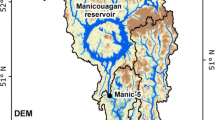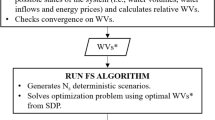Abstract
One of the greatest challenges in the electricity generation sector is to operate hydrothermal plants in view of the randomness of hydrological events and climate change, that may impact the inflows into the systems. In several Brazilian watersheds, conflicts among water users are already registered, in addition to inflow changes that affect the electricity generation system. The São Francisco River Basin (SFRB) is an important source of water for the development of northeastern Brazil. In this context, this work aimed at carrying out a study on the statistical behavior of time series related to the management of the SFRB hydrosystem network, as well as to measure the performance of hydropower plants in supplying multiple users, in different critical periods. Historical records of natural streamflow, natural inflow energy and stored energy were used. Some statisctical tests were applied to detect trends and change-points. The Natural Energy method was applied to different subsamples to define critical periods. Next, a deterministic nonlinear operation optimization model was used to assess the supply to the multiple users for the different critical periods. The main contribution of this study is the impact of nonstationarity in planning and operation of hydrosystems. The results indicated that the natural inflow energy and the stored energy time series are predominantly non-stationary, with a trend change in the 1990s, which modifies the critical period of the basin to 2013–2019, significantly increasing the vulnerability of the system in about 35% when compared to the currently used critical period (1949–1956).














Similar content being viewed by others
References
Ahmad A, El-Shafie A, Razali SFM, Mohamad ZS (2014) Reservoir optimization in water resources: A review. Water Resour Manag 28 (11):3391–3405. https://doi.org/10.1007/s11269-014-0700-5
Ahmadianfar I, Bozorg-Haddad O, Chu X (2019) Optimizing multiple linear rules for multi-reservoir hydropower systems using an optimization method with an adaptation strategy. Water Resour Manag 33(12):4265–4286. https://doi.org/10.1007/s11269-019-02364-y
Ahn KH, Palmer RN (2016) Trend and variability in observed hydrological extremes in the United Sates. J Hydrol Eng 21(2):04015061. https://doi.org/10.1061/(ASCE)HE.1943-5584.0001286
Alahdin S, Ghafouri HR, Haghighi A (2019) Multi-reservoir system operation in drought periods with balancing multiple groups of objectives. KSCE J Civ Eng 23(2):914–922. https://doi.org/10.1007/s12205-018-0109-4
ANA (2011) Qualificação de Dados Hidrológicos e Reconstituição de Vazões Naturais no País. Nacional Water Agency
ANA (2013) Documento base para subsidiar a revisão do Plano Decenal de Recursos Hídricos da Bacia Hidrográfica do Rio São Francisco (2004-2013). Nacional Water Agency
ANA (2017) Resolução n∘ 2.081 de 04 de dezembro de 2017. Nacional Water Agency
ANA (2018) Resolução n∘ 90 de 26 de novembro de 2018. Nacional Water Agency
ANA (2019) Manual de Usos Consuntivos da Água no Brasil. Agência Nacional de Águas
ANEEL (2020) Big - banco de informações de geração. http://www2.aneel.gov.br/aplicacoes/capacidadebrasil/capacidadebrasil.cfm
Assis JMO, Souza WM, Sobral MdC (2015) Análise climática da precipitação no submédio da bacia do rio São F rancisco com base no índice de anomalia de chuva. Revista Bras Ciê,ncias Ambientais (36) 115–127. https://doi.org/10.5327/Z2176-947820151012
Basistha A, Arya DS, Goel NK (2009) Analysis of historical changes in rainfall in the Indian Himalayas. Int J Climatol 29 (4):555–572. https://doi.org/10.1002/joc.1706
Bezanson J, Edelman A, Karpinski S, Shah VB (2017) Julia: A fresh approach to numerical computing. SIAM Rev 59(1):65–98. https://doi.org/10.1137/141000671
Borges PA, Franke J, Silva FDS, Weiss H, Bernhofer C (2014) Differences between two climatological periods (2001–2010 vs. 1971–2000) and trend analysis of temperature and precipitation in C entral B razil. Theor Appl Climatol 116 (1–2):191–202. https://doi.org/10.1007/s00704-013-0947-4
Brêda JPLF, de Paiva RCD, Collischon W, Bravo JM, Siqueira VA, Steinke EB (2020) Climate change impacts on S outh A merican water balance from a continental-scale hydrological model driven by CMIP5 projections. Clim Chang 159(4):503–522. https://doi.org/10.1007/s10584-020-02667-9
CCEE (2020) Ccee - deck de preços - download dos dados de entrada e saída. https://www.ccee.org.br/portal/faces/pages_publico/o-que-fazemos/como_ccee_atua/precos/deck_de_precos
Celeste AB, Billib M (2010) The role of spill and evaporation in reservoir optimization models. Water Resour Manag 24(4):617–628. https://doi.org/10.1007/s11269-009-9468-4
Coelho M, Fernandes CVS, Detzel DHM (2019) Uncertainty analysis in the detection of trends, cycles, and shifts in water resources time series. Water Resour Manag 33(8):2629–2644. https://doi.org/10.1007/s11269-019-02210-1
Cunha APMA, Tomasella J, Ribeiro-Neto GG, Brown M, Garcia SR, Brito SB, Carvalho MA (2018) Changes in the spatial-temporal patterns of droughts in the B razilian N ortheast. Atmospheric Sci Lett 19(10):e855. https://doi.org/10.1002/asl.855
Cunha APMA, Zeri M, Deusdará Leal K, Costa L, Cuartas LA, Marengo JA, Tomasella J, Vieira RM, Barbosa AA, Cunningham C, Garcia JVC, Broedel E, Alvalá R, Ribeiro-Neto G (2019) Extreme drought events over B razil from 2011 to 2019. Atmosphere 10(11):642. https://doi.org/10.3390/atmos10110642
Deser C, Phillips AS, Alexander MA (2010) Twentieth century tropical sea surface temperature trends revisited. Geophys Res Lett 37(10):L10701. https://doi.org/10.1029/2010GL043321
Dunning I, Huchette J, Lubin M (2017) J uMP: A modeling language for mathematical optimization, vol 59. https://doi.org/10.1137/15M1020575
Guo LP, Yu Q, Gao P, Nie XF, Liao KT, Chen XL, Hu JM, Mu XM (2018) Trend and change-point analysis of streamflow and sediment discharge of the G ongshui river in C hina during the last 60 years. Water 10(9):1273. https://doi.org/10.3390/w10091273
Hashimoto T, Stedinger JR, Loucks DP (1982) Reliability, resiliency, and vulnerability criteria for water resource system performance evaluation. Water Resour Res 18(1):14–20. https://doi.org/10.1029/WR018i001p00014
Haylock MR, Peterson TC, Alves LM, Ambrizzi T, Anunciação YMT, Baez J, Barros VR, Berlato MA, Bidegain M, Coronel G, et al. (2006) Trends in total and extreme S outh A merican rainfall in 1960–2000 and links with sea surface temperature. J Clim 19(8):1490–1512. https://doi.org/10.1175/JCLI3695.1
de Jong P, Tanajura CAS, Sánchez A S, Dargaville R, Kiperstok A, Torres EA (2018) Hydroelectric production from B razil’s São F rancisco river could cease due to climate change and inter-annual variability. Sci Total Environ 634:1540–1553. https://doi.org/10.1016/j.scitotenv.2018.03.256
Kendall M (1962) Rank correlation methods. Theory and applications of rank order-statistics, Hafner Pub. Co
Machiwal D, Jha MK (2012) Hydrologic time series analysis: theory and practice. Springer, New York
Mann HB, Whitney DR (1947) On a test of whether one of two random variables is stochastically larger than the other. Ann Math Stat 18(1):50–60. https://doi.org/10.1214/aoms/1177730491
Melo E, Oliveira F, Pruski F, Figueiredo J, Rodriguez R (2008) Impacto do uso de vazões naturais em estudos hidrológicos. Braz J Water Resour 13(3):191–197. https://doi.org/10.21168/rbrh.v13n3.p191-197
Melo MMMS, CACd S, RAd O, Silva MT, Abrahão R, Ruiz-Alvarez O (2018) Trends in temperature and rainfall extremes near the A rtificial S obradinho L ake, B razil. Revista Bras Meteorol 33(3):426–440. https://doi.org/10.1590/0102-7786333003
Mendes LA, Barros MTL, Zambon RC, Yeh WWG (2015) Trade-off analysis among multiple water uses in a hydropower system: Case of São F rancisco river basin, B razil. J Water Resour Plan Manag 141(10):04015014:1–10. https://doi.org/10.1061/(ASCE)WR1943-5452.0000527
Myronidis D, Ioannou K, Fotakis D, Dörflinger G (2018) Streamflow and hydrological drought trend analysis and forevcasting in C yprus. Water Resour Manag 32(5):1759–1776. https://doi.org/10.1007/s11269-018-1902-z
Naghettini M (ed) (2017) Fundamentals of Statistical Hydrology. Springer International Publishing, New York. https://doi.org/10.1007/978-3-319-43561-9
Nashwan MS, Shahid S, Abd Rahim N (2019) Unidirectional trends in annual and seasonal climate and extremes in E gypt. Theor Appl Climatol 136 (1–2):457–473. https://doi.org/10.1007/s00704-018-2498-1
Neira KL (2005) Curvas de regularização para reservatórios parcialmente cheios e confiabilidade constante. PhD thesis, Universidade Federal do Paraná
Nepal S (2016) Impacts of climate change on the hydrological regime of the K oshi river basin in the H imalayan region. J Hydro-environ Res 10:76–89. https://doi.org/10.1016/j.jher.2015.12.001
Oliveira PT, Silva CMS, Lima KC (2014) Linear trend of occurrence and intensity of heavy rainfall events on N ortheast B razil. Atmospheric Sci Lett 15(3):172–177. https://doi.org/10.1002/asl2.484
ONS (2019a) Plano da Operação Energética 2019-2023. National Electric System Operator
ONS (2019b) Regras de operação de controle de cheias - bacia do rio São Francisco (ciclo 2019-2020). National Electric System Operator
ONS (2020) Resultados da operação: Histórico da operação. http://www.ons.org.br/Paginas/resultados-da-operacao/historico-da-operacao/capacidade/_instalada.aspx
Pereira SB, Pruski FF, DDd Silva, Ramos MM (2009) Net evaporation in S obradinho dam and impacts on runoff due to the construction of the reservoir. Revista Bras Eng Agrí,cola Ambiental 13(3):346–352. https://doi.org/10.1590/S1415-43662009000300018
Pettitt AN (1979) A non-parametric approach to the change-point problem. Appl Stat 28(2):126. https://doi.org/10.2307/2346729
Reyer CP, Adams S, Albrecht T, Baarsch F, Boit A, Canales Trujillo N, Cartsburg M, Coumou D, Eden A, Fernandes E et al (2017) Climate change impacts in L atin A merica and the C aribbean and their implications for development. Regional Environ Chang 17(6):1601–1621. https://doi.org/10.1007/s10113-015-0854-6
Roman P (2017) The São F rancisco interbasin water transfer in B razil: Tribulations of a megaproject through constraints and controversy. Water Altern 10 (2):395–419
Sa’adi Z, Shahid S, Ismail T, Chung ES, Wang XJ (2017) Distributional changes in rainfall and river flow in S arawak, M alaysia. Asia-Pac J Atmospheric Sci 53(4):489–500. https://doi.org/10.1007/s13143-017-0051-2
Samadi-koucheksaraee A, Ahmadianfar I, Bozorg-Haddad O, Asghari-pari SA (2019) Gradient evolution optimization algorithm to optimize reservoir operation systems. Water Resour Manag 33(2):603–625. https://doi.org/10.1007/s11269-018-2122-2
Santos HA, Pompeu PS, Kenji DOL (2012) Changes in the flood regime of São F rancisco river (B razil) from 1940 to 2006. Regional Environ Chang 12(1):123–132. https://doi.org/10.1007/s10113-011-0240-y
Siegel S (1956) Nonparametric statistics for the behavioral sciences, 1st edn. McGraw-Hill Inc, New York
Silva WL, Xavier LNR, Maceira MEP, Rotunno OC (2019) Climatological and hydrological patterns and verified trends in precipitation and streamflow in the basins of B razilian hydroelectric plants. Theor Appl Climatol 137(1–2):353–371. https://doi.org/10.1007/s00704-018-2600-8
Spearman C (1904) The proof and measurement of association between two things. Am J Psychol 15(1):72. https://doi.org/10.2307/1412159
Tiezzi RO, Barbosa PSF, Lopes JEG, Francato AL, Zambon RC, Silveira A, Menezes PHBJ, Isidoro JMGP (2019) Trends of streamflow under climate change for 26 B razilian basins. Water Policy 21(1):206–220. https://doi.org/10.2166/wp.2018.207
Trejo FP, Brito-Castillo L, Alves HB, Guevara E (2016) Main features of large-scale oceanic-atmospheric circulation related to strongest droughts during rainy season in B razilian São F rancisco river basin. Int J Climatol 36 (12):4102–4117. https://doi.org/10.1002/joc.4620
Vera LHA, Montenegro SMGdL, Silva SR (2017) Performance of water usage charge in the N ation’s domain as a water resource management tool in the São F rancisco river basin. Braz J Water Resour 22(7). https://doi.org/10.1590/2318-0331.011715171
Viola MR, Mello CR, Beskow S, Norton LD (2014) Impacts of land-use changes on the hydrology of the G rande river basin headwaters, S outheastern B razil. Water Resour Manag 28(13):4537–4550. https://doi.org/10.1007/s11269-014-0749-1
Wang J, Cheng C, Shen J, Cao R, Yeh WWG (2018) Optimization of large-scale daily hydrothermal system operations with multiple objectives. Water Resour Res 54(4):2834–2850. https://doi.org/10.1002/2017WR021291
Zambon RC, Barros MTL, Lopes JEG, Barbosa PSF, Francato AL, Yeh WWG (2012) Optimization of large-scale hydrothermal system operation. J Water Resour Plan Manag 138(2):135–143. https://doi.org/10.1061/(ASCE)WR.1943-5452.0000149
Zambon RC, Barros MTL, Yeh WWG (2019) Storage, productivity, and resilience in the B razilian hydropower system. In: World environmental and water resources congress 2019, american society of civil engineers, pp 98–106. https://doi.org/10.1061/9780784482339.011
Zhang X, Zwiers FW, Hegerl GC, Lambert FH, Gillett NP, Solomon S, Stott PA, Nozawa T (2007) Detection of human influence on twentieth-century precipitation trends. Nat 448(7152):461–465. https://doi.org/10.1038/nature06025
Acknowledgements
The first author acknowledges the Coordination for the Improvement of Higher Education Personnel (CAPES/Brazil), the Research Supporting Foundation of the State of Sergipe (FAPITEC-SE) and the Provost Office of Research of the Federal University of Sergipe (POSGRAP/UFS) for the financial support.
Author information
Authors and Affiliations
Corresponding author
Ethics declarations
Conflict of Interests
The authors declare that they have no conflict of interest.
Additional information
Publisher’s Note
Springer Nature remains neutral with regard to jurisdictional claims in published maps and institutional affiliations.
Rights and permissions
About this article
Cite this article
Barbosa, A.d.G., Celeste, A.B. & Mendes, L.A. Influence of Inflow Nonstationarity on the Multipurpose Optimal Operation of Hydropower Plants Using Nonlinear Programming. Water Resour Manage 35, 2343–2367 (2021). https://doi.org/10.1007/s11269-021-02812-8
Received:
Accepted:
Published:
Issue Date:
DOI: https://doi.org/10.1007/s11269-021-02812-8




